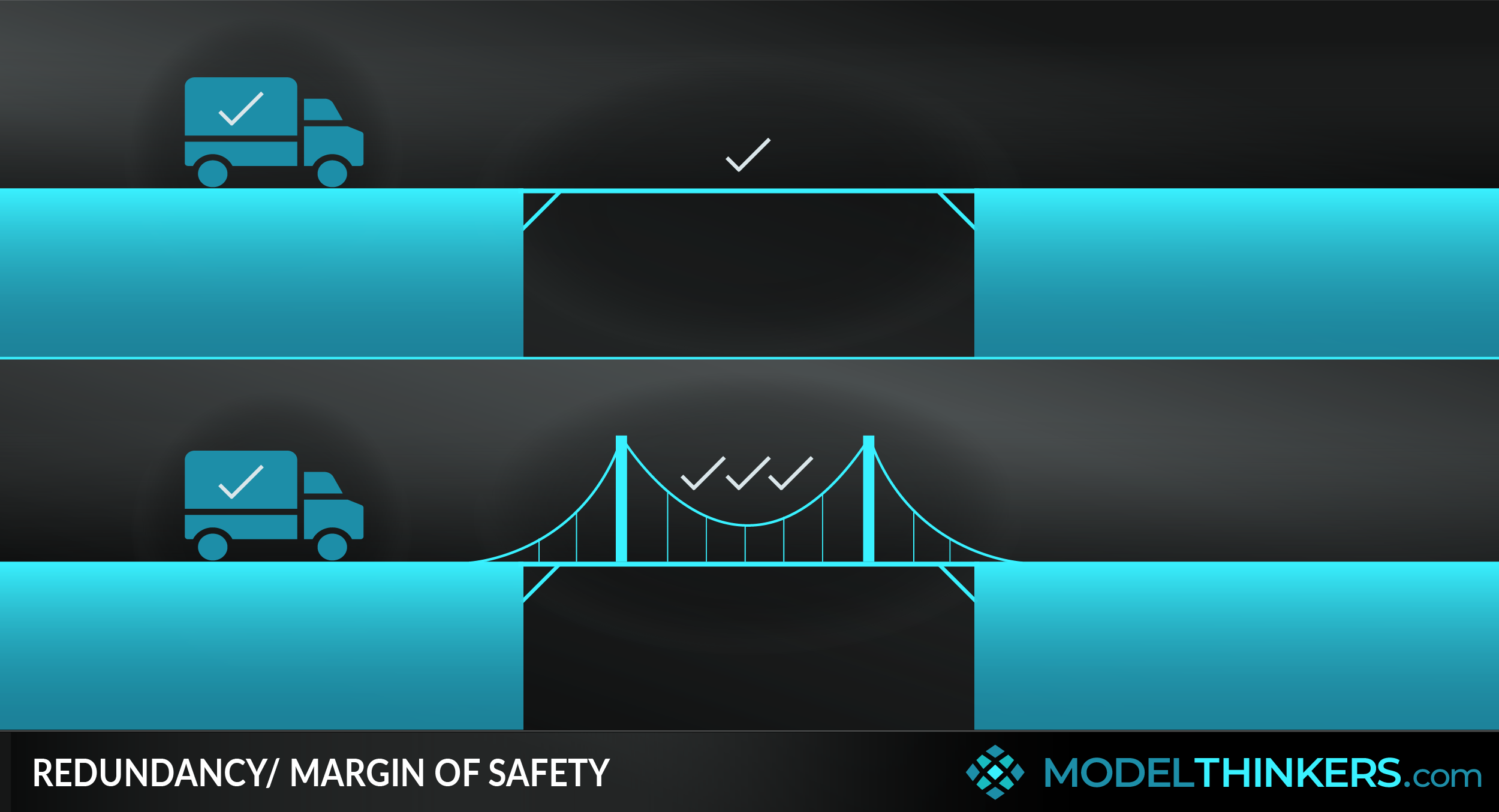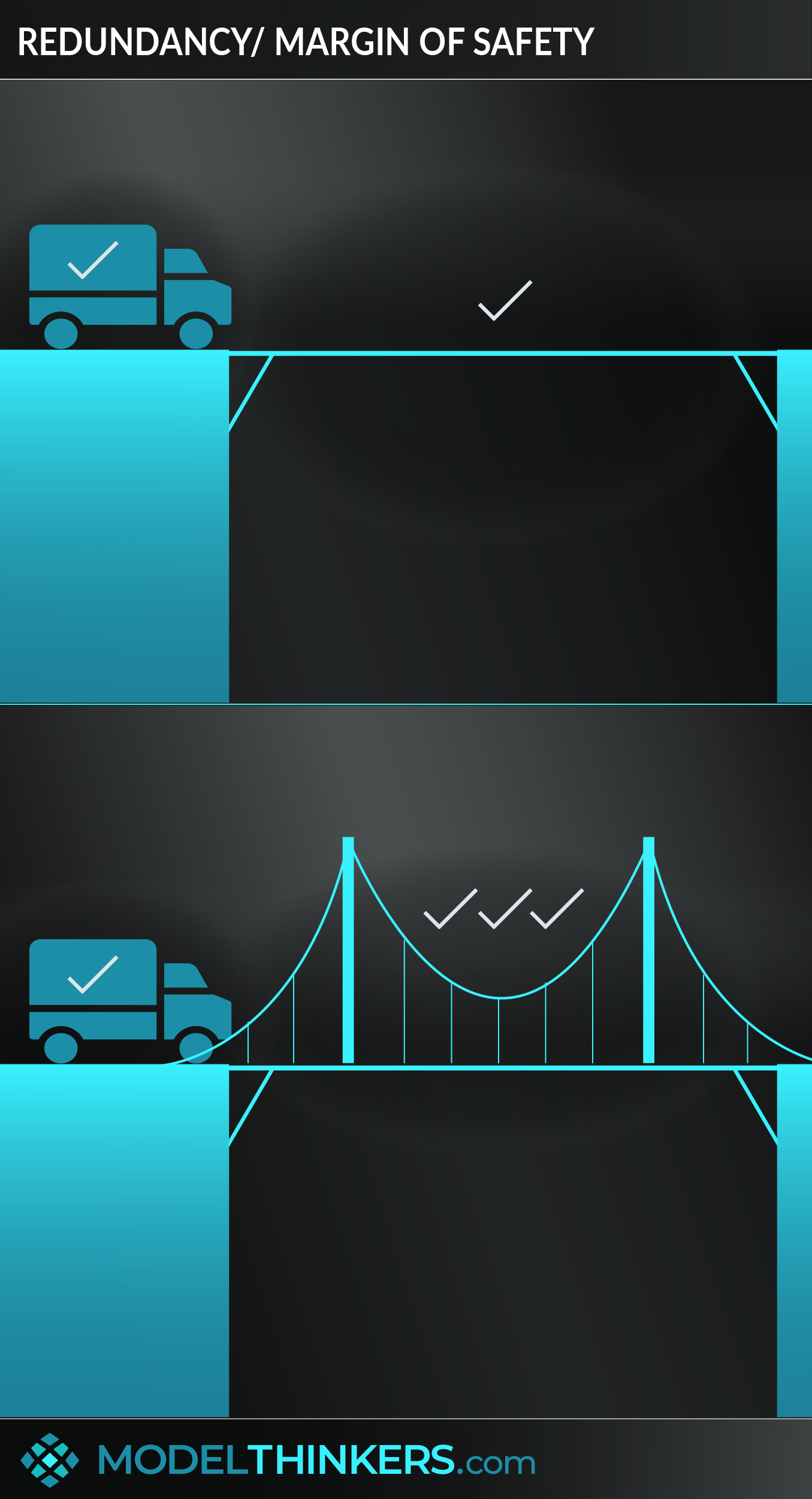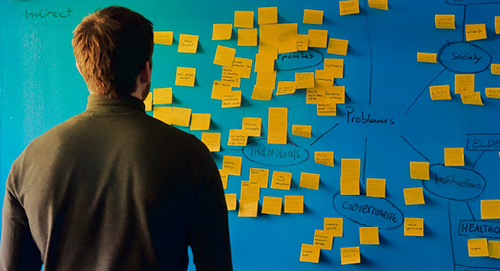

 0 saved
0 saved
 7.4K views
7.4K views








Because things go wrong, plans go awry, and 'stuff' happens.
Redundancy and Margin of Safety are mental models that support the use of backups and contingencies in case of failure or problems.
REDUNDANCY.
Redundancy involves duplicating critical elements of a system to provide alternatives and reduce the risk of failure. Put simply, it means building backup processes into a solution so there is more than one way to achieve the desired goal.
MARGIN OF SAFETY.
The Margin of Safety is a similar concept but rather than duplicating critical components of a system in the form of a backup, developing for margin of safety involves building for higher loads than believed necessary.
A TRUCK AND A BRIDGE.
For example, if you needed to build a bridge to support 3-tonne trucks, building with redundancy might mean ensuring that the key load-bearing elements, the ones most susceptible to failure, have backups. Designing with a margin of safety might involve designing the bridge as a whole to withstand 10-tonnes.
APPLICATIONS.
Other examples of both these elements include carrying a spare tyre; organising a phone number back up for an online meeting; or maintaining an emergency cash fund ‘just in case’.
In accounting, the margin of safety is the difference between break-even sales and actual sales. In business, Redundancy and Margin of Error allow an organisation to prosper even with occasional mismanagement or unexpected events. It involves designing with a ‘buffer zone’ and contingency plan for unexpected occurrences.




- Define your requirements, then double them.
Consider what is required for a situation or challenge. Put numbers to the resources and inputs that will contribute to its success. Once defined, consider doubling them before designing your solution.
- Combine with inversion and use the pre-mortem.
In the inversion mental model, we outlined the use of pre-mortems to identify fail points before they happen. Using this process helps to identify ‘weak points’ and build in redundancy accordingly.
- Use Margin of Safety in investments
Maintaining a Margin of Safety in investments is crucial because of their inherent complexity and likelihood of miscalculations. Buying a business for exactly what you believe it’s worth offers no margin of safety for any foreseen or unpredictable elements.
Redundancy and designing with Margin of Safety generally adds complexity, which adds its own risks and can lead to other types of unpredicted failure. It can also add cost and might be prohibitive to apply to projects in competitive environments.
Redundancy can also lead to complacency, possibly encouraging you to take more risks because you believe that your backups will cope and/or not fully committing to anyone approach because of the contingencies in place.
Redundancy and margins of safety cannot solve all reliability problems, neither is it a cure for problematic initial design.
Succession planning.
Organisations that are point sensitive on key talent to produce their value are often charged to implement early succession planning options, defraying the risk on key staff.
Dual modular redundancy.
Dual and triple modular redundancy is built into hardware solutions as part of reliability engineering. This approach duplicates a system, so the backups can take over when one component fails. For example, a computer might have multiple redundant nodes and has been known to be used by the UK Royal Navy as part of its submarine design.
Redundancy is a favourite model of Charlie Munger who said “the engineering idea of a backup system is a very powerful idea.”
Use the following examples of connected and complementary models to weave redundancy and margin of safety into your broader latticework of mental models. Alternatively, discover your own connections by exploring the category list above.
Connected models:
- Bottleneck: considering possible points of failure to design around.
- Inversion: considering what might go wrong to design around.
- Diversification: a related but different risk mitigation strategy.
Complementary models:
- Systems vs goals: consider how to incorporate redundancy in daily systems.
- Black swan event: designing for unpredictability.
- Peltzman effect: a potential negative implication for designing with redundancy.
Redundancy originated in reliability engineering, where more than one means is created to accomplish a given task. All those means need to fail before there is a system failure.
Read Poor Charlie's Almanack: The Wit and Wisdom of Charles T. Munger to find out how redundancy applies in business.
 My Notes
My Notes
Oops, That’s Members’ Only!
Fortunately, it only costs US$5/month to Join ModelThinkers and access everything so that you can rapidly discover, learn, and apply the world’s most powerful ideas.
ModelThinkers membership at a glance:






“Yeah, we hate pop ups too. But we wanted to let you know that, with ModelThinkers, we’re making it easier for you to adapt, innovate and create value. We hope you’ll join us and the growing community of ModelThinkers today.”




